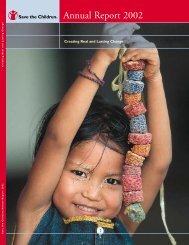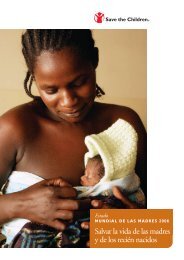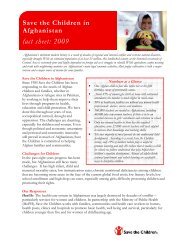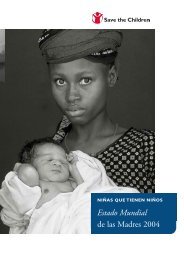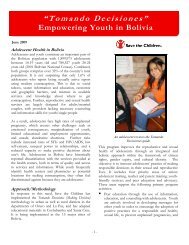The Power and Promise of Girls' Education - Save the Children
The Power and Promise of Girls' Education - Save the Children
The Power and Promise of Girls' Education - Save the Children
You also want an ePaper? Increase the reach of your titles
YUMPU automatically turns print PDFs into web optimized ePapers that Google loves.
<strong>The</strong> Asian Miracle<br />
By 2010, experts project that, without dramatic<br />
intervention, an additional 10 million children will have<br />
lost one or both parents to AIDS. <strong>The</strong> future <strong>of</strong> this<br />
epidemic may be determined by how well <strong>the</strong> world<br />
equips its children – especially girls – with <strong>the</strong> skills,<br />
knowledge <strong>and</strong> attitudes to prevent infection.<br />
Fuel for economic growth <strong>and</strong> greater<br />
investments in children<br />
Research consistently shows that economic growth is<br />
fueled when all children, but especially girls, attend<br />
school. During <strong>the</strong> 1990s, <strong>the</strong> nations <strong>of</strong> <strong>the</strong> world<br />
formally recognized that no country had emerged from<br />
third world status without educating its citizens, <strong>and</strong> that<br />
girls’ education is strongly associated with increased<br />
economic productivity. 29<br />
Access to education helps girls to gain <strong>the</strong> knowledge<br />
<strong>and</strong> skills needed to earn a livelihood, <strong>and</strong> to have fewer<br />
children, giving families greater capacity to care for <strong>the</strong><br />
children <strong>the</strong>y do have, <strong>and</strong> to save money. This savings<br />
provides new capital needed for economic growth. 30 It is<br />
estimated that a 1 percent increase in female education<br />
would increase <strong>the</strong> average level <strong>of</strong> GDP by 0.37 percent<br />
(by increasing <strong>the</strong> number <strong>of</strong> women working <strong>and</strong> saving<br />
money). 31<br />
Two separate education-related factors can be harmful<br />
to economic growth: low levels <strong>of</strong> female enrollment in<br />
school <strong>and</strong> differences between boys <strong>and</strong> girls in school<br />
enrollment (gender imbalance). Societies that have a<br />
preference for not investing in girls can pay a price for<br />
it in terms <strong>of</strong> slower growth <strong>and</strong> reduced income. 32<br />
A boost for democracy <strong>and</strong> civic<br />
participation<br />
Where children, both girls <strong>and</strong> boys, have access to<br />
basic education, countries are more likely to embrace<br />
democratic practices. Civil society groups – such as<br />
farmers’ cooperatives, parent associations <strong>and</strong> women’s<br />
self-help groups – are also more likely to flourish <strong>and</strong> act<br />
as partners with government for social improvement <strong>and</strong><br />
economic development. When girls’ education rates rise,<br />
<strong>and</strong> women participate more in civic groups <strong>and</strong> political<br />
decision-making, <strong>the</strong>y tend to support changes that<br />
Investing in <strong>the</strong> education <strong>of</strong> young girls is considered by<br />
many international economists to be <strong>the</strong> single best<br />
investment a developing country can make to improve its<br />
social well-being <strong>and</strong> its economic prospects.Advancements<br />
in girls’ education played a key role in helping transform<br />
some Asian nations during <strong>the</strong> past half-century.<br />
In 1950,Asia's education levels <strong>and</strong> literacy rates – as well<br />
as its economic status – were roughly <strong>the</strong> same as many<br />
countries today in sub-Saharan Africa, <strong>the</strong> world's poorest<br />
region.Today, 94 percent <strong>of</strong> Asia's adult population can read<br />
<strong>and</strong> write. Four <strong>of</strong> <strong>the</strong>se countries – Indonesia, South<br />
Korea,Taiwan <strong>and</strong> Thail<strong>and</strong> – import American goods <strong>and</strong><br />
services worth more than all <strong>the</strong> U.S. economic assistance<br />
dollars <strong>the</strong>y received since 1961.<br />
<strong>The</strong> striking comparison between South Korea <strong>and</strong> Pakistan<br />
illustrates <strong>the</strong> power <strong>of</strong> investing in primary education for<br />
girls <strong>and</strong> boys alike. In 1960, South Korea <strong>and</strong> Pakistan had<br />
<strong>the</strong> same per capita GDP, but South Korea had a primary<br />
school enrollment ratio <strong>of</strong> 94 percent, compared to<br />
Pakistan’s 30 percent.A 94 percent overall enrollment ratio<br />
meant most girls in South Korea were going to school,<br />
while Pakistan’s 30 percent enrollment ratio indicated few<br />
children were being educated, <strong>and</strong> <strong>the</strong> majority <strong>of</strong> those<br />
who did go to school were boys. By 1996, South Korea’s<br />
GDP per capita was three times that <strong>of</strong> Pakistan’s. 33<br />
<strong>The</strong> “Asian miracle” is <strong>the</strong> world's most dramatic example<br />
<strong>of</strong> how quality education for girls, combined with increased<br />
use <strong>of</strong> family planning <strong>and</strong> improved health <strong>and</strong> nutrition<br />
can transform nations within a single generation.<br />
Sources: Asian Development Bank (1997), East West Center<br />
Program on Population (1996),World Bank (1993) <strong>and</strong><br />
Population Action International (www.populationaction.org)<br />
contribute to better health, education <strong>and</strong> protections<br />
for children.<br />
In 1999, a 100-country study found that educating girls<br />
<strong>and</strong> reducing <strong>the</strong> gender gap tend to promote<br />
democracy. It concluded that “exp<strong>and</strong>ed educational<br />
opportunities for females goes along with a social<br />
structure that is generally more participatory <strong>and</strong>, hence,<br />
more receptive to democracy.” 34<br />
Educated girls grow up to be literate women who are<br />
better prepared to make informed political choices.<br />
<strong>Education</strong> also gives <strong>the</strong>m <strong>the</strong> self-confidence <strong>the</strong>y need<br />
to engage in political discussion <strong>and</strong> to influence<br />
decisions. A study in Bangladesh found that educated<br />
women are three times as likely as illiterate women to<br />
participate in political meetings. 35 And in Nepal, almost<br />
half <strong>of</strong> rural women who completed a nine-month<br />
literacy course said that <strong>the</strong>y would be confident about<br />
expressing <strong>the</strong>ir views to <strong>the</strong> community, compared<br />
with only 4 percent <strong>of</strong> non-literate women. 36<br />
14<br />
THE POWER AND PROMISE OF GIRLS’ EDUCATION




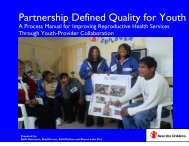

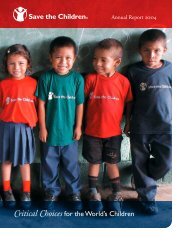
![View full document [PDF 3.39 MB] - PreventionWeb](https://img.yumpu.com/27308954/1/190x245/view-full-document-pdf-339-mb-preventionweb.jpg?quality=85)
